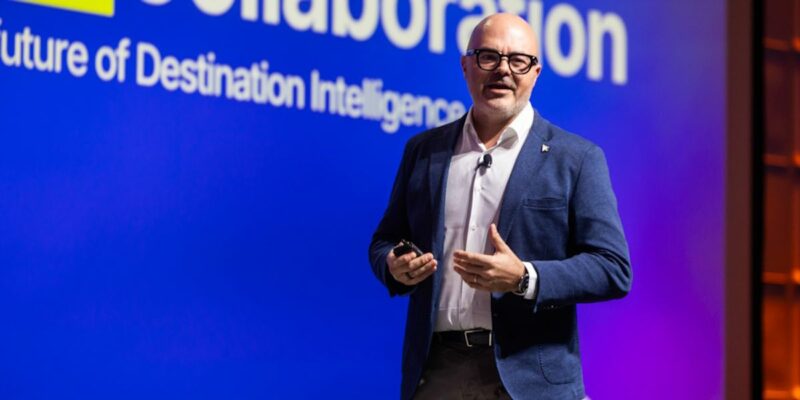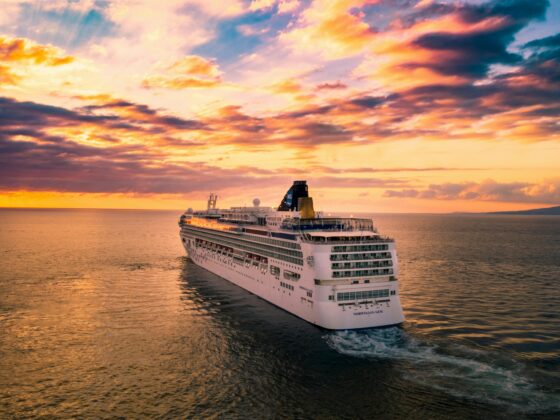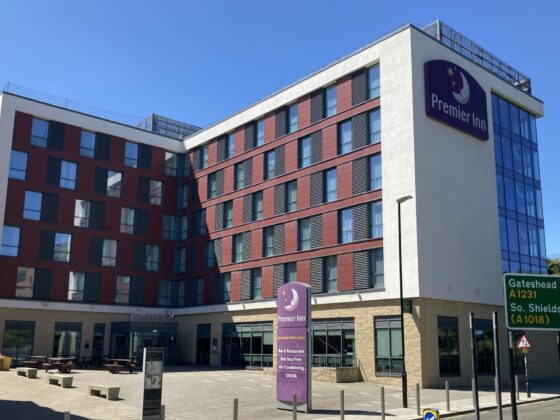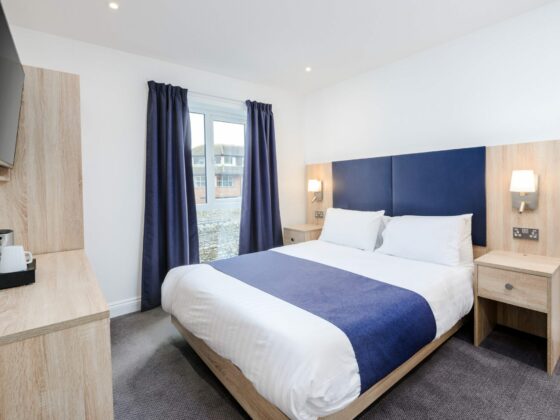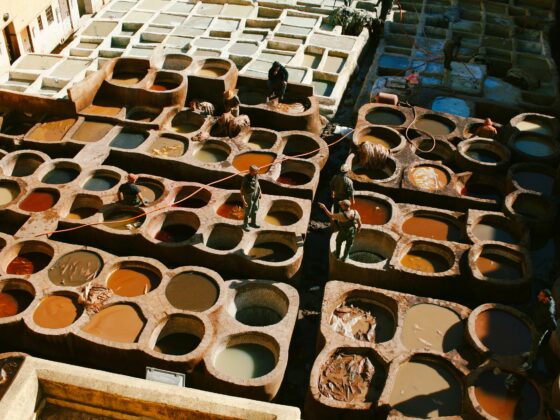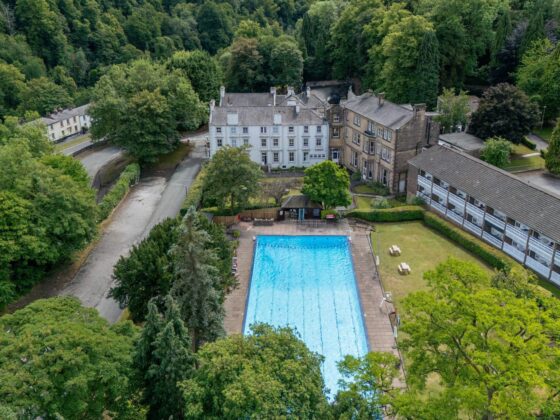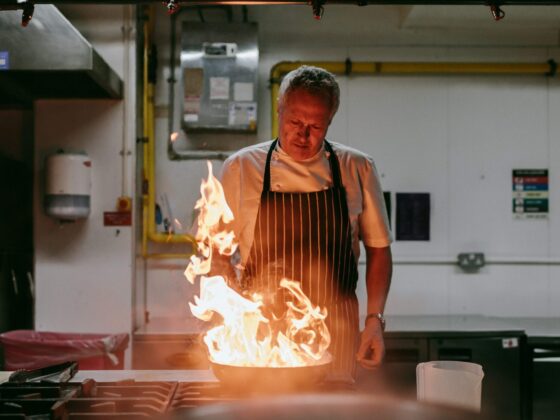Margot: I grew up in Philadelphia, and I think we had like a dinner guest when I was maybe 13, and they were talking about this thing called studying abroad. And I was like, I want to do that. And then I did it a lot. So, I tried to go abroad between high school and college. My parents were sort of like, what’s that? No, you’re going straight to college. So I was like, Okay, I’m going. But then, as soon as I could study abroad, I did, and I went to Chile. Then, I was supposed to come back and start my second semester. And I said, No, thanks. And I went abroad again. This time I did AIDS prevention research in Brazil. And then I had to sort of scramble and throw things together to graduate on time. And then I would, I would waitress, I would have jobs here and there. And I always would just save up and then spend everything traveling. And at some point in my life, I knew that I was going to be in hospitality, but the way I thought it was going to manifest is. I pictured myself being like a wild, gray-haired 85-year-old woman living in like Provence somewhere raising goats and making goat cheese and serving like burnt muffins to backpackers That’s how I thought my life was gonna play out I was like I’ll have this corporate job and I’ll be a so-and-so and then I’ll like retire there and it’s funny that I also pictured myself like alone like some kind of spinster with my goats But that’s really, that’s how I envisioned my life playing out. So I had really big dreams. And then I actually ended up going to an international graduate school program, also still pursuing a sort of international life. There’s a program at Wharton where in addition to the Wharton MBA, it’s called the Lauder program, and you go to school a little bit longer. You get a dual master’s in international studies. You have to speak state department-level second language. Mine was Spanish. And so, through that, I also lived in a few different countries and got to do incredible things. I wrote a master’s thesis on alternative forms of hospitality, and we studied agro-tourism. We studied, Spain has this program where they rehabilitate castles and put hotels in them. I got to meet with business leaders in all kinds of different countries. It was really enriching. And I really wanted to have a global career. And at the time, I was sort of in this marketing branding career track, and I actually went to work for Mattel in Los Angeles. So I chose that because most companies are structured multinationally where if you go into brand management or consumer products, you’ll end up working for the U.S. market primarily for most of your career until you get to be C-level and then maybe have a chance to go abroad, whereas toys are structured globally. So after a couple of years, I got the offer to go work abroad and it was really exciting. I was presiding over all of the entertainment brands, so Mattel and Disney. I got an offer to go to Barcelona and offer to go to Poland and be in charge of EMEA, emerging markets, really exciting stuff. And headquarters wouldn’t let me go. So it was just sort of like a frustrating time to be in this corporate environment. And I loved everyone I worked with. It was really creative. I got this international experience of understanding different markets. But it wasn’t really living out the sort of dream that I had for that job. And then I just randomly got introduced to a friend who had just bought a Boutique Noah bed and breakfast in Todos Santos. And one conversation where I was going to give her some marketing tips turned into two or three conversations, turned into, would you fly down here and check it out, turned into, would you maybe help us open this? turn into my life. So I helped them launch this boutique hotel and I pitched it as this is a sabbatical. I’ll take a six-week leave. I’ll kind of give you your standard operating procedures. I’ll give you your launch strategy. I’ll get you up and running and I will go back to LA. And I didn’t go back. And then I helped the owner of that property launch a glamping. I know glamping is like not everyone’s favorite word anymore but I helped her launch that business also in Todos Santos, Mexico. And then I started to try to develop an idea for my own project. I really wanted to create something that could become a collection. And at the time I noticed this growing trend in people who work remotely. And I also was reading white papers from HR companies, looking at the fact that this was going to become a growing trend also among businesses. In other words, businesses are recognizing that this is sort of a way to increase productivity and work-life balance. And so I thought there was a really great story around it. And that’s why I came up with the concept for Avenida Baja, which was designed to be this sort of remote work. outlet where it was like for remote workers and a co-working space and really designed with the remote work mentality in mind. And that was really my first experience creating my own space. And then once I did that, something really clicked and the way that people resonated with it, even though it was about remote work, it was much less about the function of it and more about the way that people would give me feedback on how they felt in this space. And it surprised me because I was going through a lot in my personal life when I founded it. And it was hard. It was really hard to kind of get it off the ground. And I still don’t really see it as finished. There’s more I want to do. There’s more I want to develop. There’s more programming I want to kind of infuse. But people would say, you know, I was going through this divorce and I stayed there and I just felt so comfortable. And it was, I felt like someone had really thought through what I needed or someone would be doing their series B and they were like, yes, they were grateful for the internet, but there was something more about the way the space kind of held them. And that’s when it sort of, I realized that like the way that I feel about humans and the way I feel about people is enmeshed in the way I feel about creating space. So it’s not just about like. I want to create hotels that have this function, but like I really want to create a chain or a collection of hotels.
Josiah: I would love to hear you talk a little bit more about how you, I guess your approach to understanding segments of people that you’re trying to serve with these different concepts, because you’ve described a wide range of concepts.
Margot: I don’t know. It’s funny. I mean, there are two ways to answer this question. And you actually just made an interesting point about me. I somehow become you know, or became this, I was sort of a fish out of water at Wharton, where among Wharton friends, it was your kind of alternative, you’re sort of different, you go to Coachella, what’s that? And then, you know, I end up my life takes this pivot, and I end up in this tiny town in Todos Santos, Mexico, full of artists and hippies. And they say to me, you’re so intense, you work all the time, what’s wrong with you? So But I think maybe through that, I learned that there are people like me, right? And so I think some of the segmentation comes from understanding how to put yourself in someone else’s shoes in business, where we talk about a psychographic profile or we talk about demographics. anyone coming on this podcast could probably speak much more intelligently about that, or at least to the same degree that data is available. But I think that the hotels that really get it are the ones that really understand who their customers are, like who the person is. And sometimes who the person is, that embodies the hotel side, right? So like, I have a for the Hope well which is my next project I have this person in mind right like it’s your. savvy British uncle who’s got a country house and you’re so lucky to get to go. But it’s this persona that we’re creating and we’re creating that to speak to the people that we understand. So I think for me, I’ve really worked towards understanding what makes people interested in staying at places and what makes them interested in traveling to different places. And then I think how it becomes an expression of aspirationally where they want to be inside themselves. I don’t know if that’s sort of getting too woo-woo, but I do think that like, do you have your travel self? Are you different when you travel?
Josiah: Yes and no. I feel like it’s an interesting question to think for us all to think about. I think what’s coming to mind for me, as you’re saying that, I think there’s a certain sense of travel can provide this opportunity to explore a different side of yourself. But at the same side, or I mean, on the other side, there’s something kind of fundamental that is constant, whether we’re at home or on the road, personality-wise, what we get excited by. I don’t know if that resonates with you, but I feel like there’s kind of a little bit of both.
Margot: Yeah, so I think on the one hand, there’s sort of like who we get to be when we travel, like what life we get to step into. And that’s different if your travel is purely functional. But I mean, even then, you might be on a business trip, but what is it that you do in your free time on that business trip, right? I think that where that starts to translate into more sort of technical side of like understanding data and demographics is knowing how to read through the difference between what someone has available to spend on travel or where someone’s traveled in the past versus what they’re likely to do next. And I think to really understand that in this next project that I’m creating, I understand there are different communities of travelers that are going to spend money on this hotel. And I know what they’re going to spend and I know why. And it’s not just the fact that there’s a huge population of New Yorkers. who will spend $600, $800, and $1200 a night ADR easily because that matches their demographic profile? It’s also the people who will spend that because it’s the one time a year. that they’ll spend that much because that’s how much it costs to have this experience that they find really aspirational, that’s exciting or interesting to them. And it’s not necessarily reflective of what they would spend on every other vacation. So if you were to look at their behavior, you might say, oh no, this is not a candidate for the Hopewell. Their normal spend on a hotel is $400 a night. They’re normally spending on flag hotels so that they can earn points. They travel with children. You might see a lot of behavior that doesn’t seem predictive, but if you understand who they are and what interests and excites them, you know that actually, these are people who can make that step up occasionally when it’s a luxury item or experience that they value. And talking about that personally, it has more to do with the fact that like I know who they are. I know them. I know what kind of people they are. I know what restaurants they go to. I know other places that they’ve enjoyed. I know what excites them. So it’s about like these personal relationships that you cultivate over the years where you just pay attention to like how people spend their money in the hospitality world and what they value. And these might be people who wouldn’t spend any money on fancy clothing or nice cars. But you have to know who the people who are going to be like that are. I want to go do that.
Josiah: So I think that’s a good segue into research and how you think about organizing that. You and I actually originally connected through the Independent Lodging Congress, you said something there that really caught my attention. And you were talking about your approach to market research. You talked about visiting all of these hotels. I’d love to hear you explain some of your process as you think about research, figuring out what is out there, as you’re conceptualizing what you can create and where there might be opportunities in the market.
Margot: You know, the question that I asked at ILC was related to the fact that, you know, I do have these hospitality properties in Todos Santos and Todos Santos is, if a listener isn’t sure what it is, it’s a good way to think about it is there’s Los Cabos, which is at this point, predominantly large scale, mid-range to super-luxury resorts. Todos Santos is like the hip little sister who likes surfing and mezcal. Right. Cabo is like the clase azul tequila and Todos Santos is artisanal mezcal that you can’t ever get again and hadn’t heard of before. And so I would like to leave Todos Santos and go to Cabo and stay at some of these flag resorts, particularly the ultra luxury and ultra-luxury. I like to learn from them. I like to see what the experience is like. And I had asked a question of Robin Kennedy actually at Montage because of the ones I had experienced, Montage really stood out. The experience was profoundly different than some of the other luxury resorts and it was very much related to the service. And it wasn’t that it was this sort of white glove, like, yes, sir, yes, ma’am experience as much as I hope that I wasn’t wrong in this, but I genuinely believed that everyone who was working there or being helpful towards me was really happy to do so. It, it, it made the experience both luxurious from the standpoint of being taken care of. and also really positive in terms of feeling like you were in an environment that was happy and welcoming, not just welcoming for the sake of being kind of subservient or obsequious.
Josiah: I’d love for you to talk a little bit more about this because I don’t know if this was your experience there, but I feel like for me that happens through so many of these little interactions you have with people and it’s really hard to script these. So it means that you need to focus on culture, you need to focus on bringing the right people on board. Was that where you’re picking this up for you? Was it all those little interpersonal interactions you had?
Margot: Or it was sort of unlikely examples, right? So sometimes I’ll go to these resorts and there’ll be like several levels of middle management and you can always spot them because they’re going to be the ones that are standing in the restaurant overseeing everything, but not picking up a dirty plate or a glass. And it’s interesting because in a lot of high-end restaurants in the US, you’ll see that the general managers, they’ll be wearing a suit and if there’s a glass empty, they’ll fill it. They are part of the team often, not always, often, because they’re really focused on the guest experience. When you sort of pluck someone and train them and then you say, you’re the manager now, Sometimes there becomes this hierarchy where it’s like, well, I put my time in and now I don’t have to do that anymore. And you can tell. And what was different about the Montage was it was an environment where everybody was really happy to help out to, you know, you’d have someone who was clearly a senior level manager. And if you asked, hey, do you know where the bathroom is? They’d walk you to the bathroom, right? Even though you could tell that was not their job. or just the fact that kind of like again using a restaurant as comparison if you go to a smaller restaurant where the staff has time to talk to you and they’ll walk you through the menu and they’ll talk about what are their favorite items and what goes really well oh the sweet potato fries go really well with this aioli i highly recommend it You don’t often get that at these huge resorts, because again, often there’s this sort of impersonal, be seen and not heard service model. And I was sort of delighted and surprised that at Montage, the staff were not afraid to be seen or heard, and in fact, really happy to say, ooh, you should try this Bellini, this one’s my favorite. And I was just impressed that they were given the opportunity to drink the Bellini.
Josiah: Thanks for walking through that because I love spotlighting where you see excellence. And Montage has beautiful properties, but it is the culture, it’s the people that set any hospitality brand apart. And so sometimes you have to experience that as a guest somewhere, even as a founder, as a entrepreneur in this space. I feel like sometimes we have to be inspired ourselves before we can go create concepts.
Margot: Yes, and also when I asked the question at ILC, my question was, you know, are you doing something differently? And it turned out the answer was, yes, very much so. We’re trying really hard to do it differently. And I thought that was interesting, too, because sometimes you think these are happy accidents or you think, you know, you’ll hear people say, we try so hard, but it’s really hard to find good waitstaff lately. Or you’ll hear people say about the industry that post-COVID, no one wants to be in the industry anymore. We’ve lost such a high percentage of the labor force. And then on the flip side, Bobby Stuckey is someone I really admire. He comes from the restaurant hospitality angle, but he’ll talk about the fact that, you know, hotels and restaurants are often like second-chance employers. They are immigrant employers. Hospitality is one of these things that unlike other skills and industries, you can train someone up from knowing nothing to being really successful. So it’s just there’s sort of those two sides of the same coin and you never know what to believe in terms of like what’s the norm. So when I asked that question about why is it that you guys are succeeding at this, I half expected them to be like, gee, thanks, I don’t know, we do our best. And instead, they were like, no, no, no, we take this really seriously. And here’s why we do it. And here’s how we do it. And that was really helpful for me.
Josiah: I want to talk about the Hopewell. Tell me how this all got started.
Margot: Yeah, well, I think as I said, you know, I really wanted to create a collection of places with spirit and I also thought a little bit about places that offered something different, which I realize probably sounds silly because I’m sure that’s what every hospitality entrepreneur says. But I grew up in Philadelphia, and there is an area about an hour north of Philadelphia, which is only an hour and 20 minutes west of Manhattan. I mean, I’m literally 80 miles from Manhattan. Some people refer to it as Bucks County, which is on the PA side, but it’s actually along the Delaware River where New Jersey and Pennsylvania meet. And there are all of these historic river towns all along it. And when I say historic, I literally mean where George Washington crossed the Delaware. That is Washington Crossing is there. It has a very kind of British countryside, rolling hills, and farmland vibes. And yet, There hasn’t really been anything dynamic, modern, luxury to come into that area. There are some bed and breakfasts that get a really high ADR, but mostly because they’re tiny, people want to go out there, and there are just very few options. And these are bed and breakfasts that have, you know, a lot of charm, but their charm is also a 1990s style jacuzzi tub in the room and like Victorian lace. It’s just different. I won’t say anything negative about these places. They are charming, but you don’t necessarily see the diversity of hospitality offerings that one might expect, given the demand for places that are within driving distance from Philadelphia and Manhattan. And I could go on and on about this, but considering there’s 30 million people spread between Philly, the sort of New Jersey, and between in Manhattan, it’s kind of astounding how few offerings there are for that community in terms of drive to hospitality. And now we’re seeing more come online and they’re all in the Catskills and the Hudson Valley. And we’re seeing these towns along the Hudson get really chic and get these cool restaurants and get these really well-designed hospitality offerings. And I just knew it was, I just knew it needed to happen along the Delaware too. And we’re arguably more convenient to get to even for New Yorkers. We also can be inclusive of people from D.C. because we’re only two to three hours from there. So you have a huge market for drive to hospitality. Very few offerings. And then you have this area that has incredible nature in terms of there’s a 50-mile towpath that you can bike on and ride on and kayak along. And there’s amazing art and there’s all of these really cool little villages that have thrift shops and antiques. And it just wasn’t that sexy yet. And I decided that I was going to make it that way. I was going to be the first one. But I also just knew that It had the best of both worlds in terms of really offering that connection to a natural environment that we crave when we live in cities, but also it’s close enough to a lot of cultural offerings so you can offer so much to your guests without necessarily having to have a full-fledged programming menu on site.
Josiah: I would like you to expand a little bit on how you thought about the different offerings that this property will have, because you do a lot of market research. You spend a lot of time kind of with different segments and kind of figuring out who wants what. I think on a national level, these sorts of drives to more outdoors-focused or adaptive reuse projects have become more popular. So you saw an opportunity geographically in the area. But also, just from the offerings that you have from this property, how did you think about what to provide that’s going to really make this stand out?
Margot: I think with adaptive reuse, to a certain degree, the property is telling you what it wants to be. I searched and searched for a place that would be some kind of boutique hospitality experience, and I found a lot of properties that were pretty expensive and had already been renovated into multimillion-dollar homes or a lot of horse farms. And I was really looking for something that was more raw. And so what appealed to me about the Hopewell is it was this old 1800s dairy farm with a number of outbuildings and a beautiful old barn that is completely untouched. There are actually two black vultures living in it right now. And then a giant farmhouse with 14 rooms. So it already had a septic permit for 27 bedrooms, and I really like that size. And then I think because of its proximity to Philadelphia, New York, Princeton University, and a lot of robust communities, it wanted to have a way to be kind of connected to the community. And so it made sense to think about it in terms of also having like a members-only social club component so that people locally could appreciate it, could enjoy the facilities, There’s a, you know, the barn wants to be a clubhouse and there’s spaces in it that are really reminiscent of like a Babington house or a Soho farmhouse. So I think the property really, in a way, again, like a lot of these properties, many of the properties that you look at that are doing these sort of drive-to rural hospitality experiences, a lot of them are new, but a lot of them are sort of new construction. And when you do adaptive reuse, you really are having to adapt. So a lot of it was like walking into these spaces and trying to feel out what does the space want to be? And then how are people going to connect with this space? In other words, when someone walks into this space, what does it feel natural for them to envision here? And that’s kind of how we evolved into where’s the check-in, where’s the dining room, where do people go to a yoga class? It’s in the hayloft, spoiler alert. So, and then, you know, where the spa treatments, and there was this area under the barn that almost is a garage, but it’s a sort of cavernous stone area. And it feels almost like a cave, like a Turkish hammam. And so that sort of wanted to be the spa area. And actually where we chose to put the pool is the sunniest spot on the lawn. And then there was this old existing swimming pool that’s completely overgrown. And I decided that we had to use it. And it just made sense that, you know, architects always talk about surprise and delight. So the way that we’re serving that at the Hopewell is by turning the old swimming pool into the deep end, which will be sort of a speakeasy-style outdoor pavilion where we’ll host live podcasts or acoustic sets or fireside chats. And it’ll be a place where you can kind of take your picnic basket and bottle of wine and go sit out outside. So.
Josiah: That sounds so fun. It takes a lot of creativity to imagine all the uses of a space like that. What’s so difficult about these projects, though, is imagining it is one thing. Then there’s typically a zoning permitting process that can be really, really hard to navigate. What have you learned through that process?
Margot: Oh, gosh, a lot of fortitude. I think what I’ve learned, I mean, I think that my advice to anyone who’s going through zoning would be like talk to absolutely everyone before you get anywhere near your application. For me, the mistake that I made is I went to the township and said, hey, here’s what we’re thinking of building. What do you think? And the township said, this is amazing. And so here we were, this property is surrounded by conservation land. There’s not a neighbor anywhere near the property. We just thought I mean we’re across the street from a public park where there’s public access and hiking trails So it seems sort of obvious and I would say that’s like lesson number one of zoning is sort of like nothing’s obvious and nothing’s in the bag yet and what I didn’t do is talk to some of the other people that live up and down that street because I thought it would be presumptuous and before getting the zoning approval to start talking to them about this great thing we’re doing. I thought that it was really important not to anger the zoning board by running around town talking about it before the zoning board had said, OK. So but I kind of think that was a mistake because what ended up happening is, you know, I think in part because I’m not a huge developer, I don’t come with a lot of obvious muscle in terms of a firm or like a company behind me. There was a gentleman who lived on the same road as the Hopewell. He had wanted to purchase it and turn it into a drug rehab facility, which evidently is like a great real estate cash cow. And I had sort of got it by making a bid and writing a letter to the owner and telling them about my plans. And I guess the way that it was explained to me is he was sort of bitter about it. And he tried to tank the project by spreading a lot of really nasty rumors about it. So they said things like I was doing a massive expansion and I was going to destroy all of the wildlife and I was going to like clear cut forest to put up parking lots. I mean, it was it literally it was like paved paradise. Put up a parking lot is what they accused me of. And here I am, this liberal tree hugger. you know, who was talking about how, like, each one of our cocktails was going to be named after an endangered bird species, and then we were going to donate a percentage of profits to conservation. But I, you know, so it just, it’s just interesting, like in politics, they say the first rumor wins, and I ended up having to battle people who I am deeply values aligned with, because this sort of savvy real estate developer set off the alarm bells and found a way to weaponized conservationists. And it led to this really protracted zoning battle where people came out to every single meeting with pitchforks, and I mean, anything you could think of. It was what you know, the trout in this stream three miles away are all going to die. And then you’d have the zoning board members saying, there are no trout in that stream. What are you talking about? We had people talking about frogs crossing the road. And what about bears? What if there’s a bear and I had said something about attracting pollinators by planting native species and someone came on and yelled at me for the fact that like what if my guests get stung by bees because I’m planting native species. I mean it was just anything and everything they could do to undermine the project and that was just on a personal level like so hard because you don’t get into this business with a desire to piss people off or prove something. You get into this because you want to create something magical and you envision it being a place that, you know, lots of hotels say they want to be part of the community. I certainly did. So, I mean, it was really, really hard and I think that that’s something that a lot of people don’t realize is there’s creating a hotel and then there’s land use development. And land use development is totally different. And I just ended up in this sort of college course I never even signed up for.
Josiah: It sounds so difficult and so painful. What did you find useful in setting the record straight and say, hey, this is actually what we’re what we’re trying to do?
Margot: I mean I learned pretty early on, I had talked to the press once or twice and realized that probably wasn’t a good idea. So I think the biggest lesson for anyone else that’s in this situation is that like trying to fight the battle across PR is not really the way to go. I think the way to go is like you keep your head down and you focus on, you know, the things that prove your own integrity. I really think that time is important. I think people need time to sort of come around. They need time to sort of see how things play out. And I think that what started to happen is that with time, more and more people, as I made myself available, as I reached out to people, more and more people talked to me. And the second they talked to me, they were like, oh, this is great. We’re really happy about this. And now I’ve built relationships with people who really want to see this particular area of New Jersey. more recognized as a tourist destination. The governor of New Jersey actually recently came and signed a bill promoting this. I’m being interviewed by a preservation fund at the state level about adaptive reuse. There’s conservationists who are really excited about what we’re going to do there. So now I have sort of a team in a community of people who are really enthusiastic about what this project is going to do and the precedent that it’s going to set for the region and hopefully to some extent nationally in terms of what you can do with sort of an old dilapidated property and how you can turn it into something really special.
Josiah: Well, I’m very excited to see what you do with this. I know we just have a few minutes left, but maybe in closing, I wonder if you could speak a little bit to some of the aspects that you’re most excited by, and then we can include links where people can learn more about this. But what are you most excited about with Hopewell right now?
Margot: I mean, I think right now, so I’m actually headed to London and the UK pretty soon. I’m taking my seven-year-old daughter for spring break and we’re visiting a lot of properties there. I always think it’s fun to learn from what some of the leaders in the field are doing. I think there are a lot of projects there where they’ve taken old country manners and rewilded areas of forest and meadow. where they’ve created programming that speaks to the conservation that they’re doing in a way that’s engaging and fun. And, you know, it’s not necessarily just a bird walk, right? It might be foraging for this certain type of herb and then making botanical cocktails with it. So I’m really excited, actually, to go learn more from what’s already been done and how to kind of take that back and infuse that into the Hopewell. I also just can’t wait to open it and host people there. I think every time an investor or someone who’s curious from the community comes to tour it, I get to do that several times a week. It’s so exciting because I can talk to it and I can present my investor deck, but when someone actually sets foot on the property and seeing their eyes light up and seeing them say, This is really special. That’s so exciting and validating, and it just kind of makes the vision come to life in someone else’s eyes, not just in mine. So that’s sort of what really gets me jazzed about the property.
Josiah: I love it, Margot. Where would you direct our listeners to go to learn more about you and what you’re doing?
Margot: You can go to the-hopewell.com. If you want to come stay in Baja, you can come to avenidabaja.com. I’m Margo Stern on LinkedIn and Instagram and I love talking to anyone. So awesome.
Josiah: This was a ton of fun. I learned a lot from you, Margo. Thanks so much for taking some time.
Margot: Yeah.

